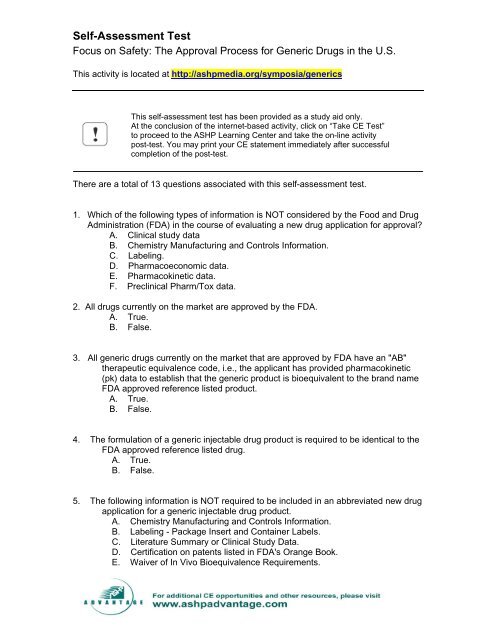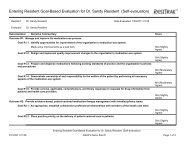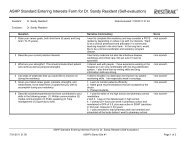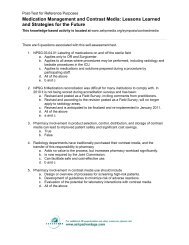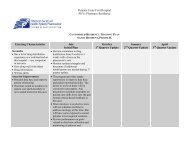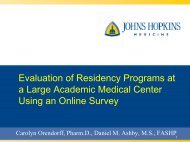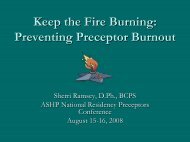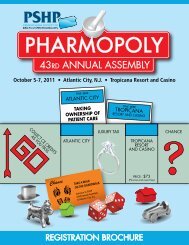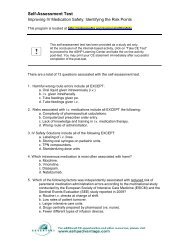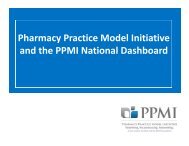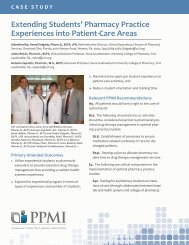Self-Assessment Test - Ashpmedia.org
Self-Assessment Test - Ashpmedia.org
Self-Assessment Test - Ashpmedia.org
Create successful ePaper yourself
Turn your PDF publications into a flip-book with our unique Google optimized e-Paper software.
<strong>Self</strong>-<strong>Assessment</strong> <strong>Test</strong>Focus on Safety: The Approval Process for Generic Drugs in the U.S.This activity is located at http://ashpmedia.<strong>org</strong>/symposia/genericsThis self-assessment test has been provided as a study aid only.At the conclusion of the internet-based activity, click on “Take CE <strong>Test</strong>”to proceed to the ASHP Learning Center and take the on-line activitypost-test. You may print your CE statement immediately after successfulcompletion of the post-test.There are a total of 13 questions associated with this self-assessment test.1. Which of the following types of information is NOT considered by the Food and DrugAdministration (FDA) in the course of evaluating a new drug application for approval?A. Clinical study dataB. Chemistry Manufacturing and Controls Information.C. Labeling.D. Pharmacoeconomic data.E. Pharmacokinetic data.F. Preclinical Pharm/Tox data.2. All drugs currently on the market are approved by the FDA.A. True.B. False.3. All generic drugs currently on the market that are approved by FDA have an "AB"therapeutic equivalence code, i.e., the applicant has provided pharmacokinetic(pk) data to establish that the generic product is bioequivalent to the brand nameFDA approved reference listed product.A. True.B. False.4. The formulation of a generic injectable drug product is required to be identical to theFDA approved reference listed drug.A. True.B. False.5. The following information is NOT required to be included in an abbreviated new drugapplication for a generic injectable drug product.A. Chemistry Manufacturing and Controls Information.B. Labeling - Package Insert and Container Labels.C. Literature Summary or Clinical Study Data.D. Certification on patents listed in FDA's Orange Book.E. Waiver of In Vivo Bioequivalence Requirements.
<strong>Self</strong>-<strong>Assessment</strong> <strong>Test</strong>Focus on Safety: The Approval Process for Generic Drugs in the U.S.This activity is located at http://ashpmedia.<strong>org</strong>/symposia/generics6. Which of the following items can be changed in an abbreviated new drug application(ANDA) for a generic injectable drug product in comparison to the FDA approvedreference listed drug?A. The conditions of use included in the package insert which are notprotected by a patent or period of market exclusivity.B. The total volume included in the vial.C. A change from a lyophilized product to a ready to use product without acitizen petition.D. Buffer, preservative or antioxidant in the formulation.E. Change in the vehicle used to deliver the product (i.e., an emulsion,liposomal system).7. Which one is NOT a characteristic of a 505(b)(2) NDA (new drug application)?A. Applicant has a right of reference to the clinical data supporting theapplication.B. Applicant must submit a patent certification for any patents covering thereference listed drug and which have been submitted to FDA's OrangeBook.C. Applicant is eligible for 5 year New Chemical Entity (NCE) and/or 3 yearHatch-Waxman exclusivity.D. Applicant must pay a user fee for review of the application.E. Applicant can make changes to an approved reference product without aCitizen Petition.8. Who is the current FDA commissioner?A. Donald Kennedy.B. David Kessler.C. Kathleen Sebelius.D. “Bo” Obama.E. Margaret Hamburg.9. Which of the following is NOT a type of market exclusivity that can be afforded to anew drug application?A. New Chemical Entity Exclusivity - five years.B. Pediatric Exclusivity - six months.C. Orphan Drug Exclusivity - seven years.D. Increased Safety Exclusivity - two years.E. Waxman- Hatch exclusivity for a new indication or use - three years.
<strong>Self</strong>-<strong>Assessment</strong> <strong>Test</strong>Focus on Safety: The Approval Process for Generic Drugs in the U.S.This activity is located at http://ashpmedia.<strong>org</strong>/symposia/generics10. Which of the following is NOT a consideration when FDA makes a determination oftherapeutic equivalence?A. Pharmaceutical equivalence, i.e., same active ingredient, dosage form,route of administration and strength.B. Products which are not subject to FDA approval but are generallyrecognized as safe and effective.C. Bioequivalence.D. Compliance with current good manufacturing practices.E. Products are adequately labeled.F. The products have been approved by FDA.11. FDA considers pharmaceutical alternatives (different salts or dosage forms) to beinterchangeable (eligible for an "A" rating) if they are shown to be bioequivalent.A. True.B. False.12. There is currently an abbreviated approval pathway for follow-on biologic productsin the US.A. True.B. False.13. The Drug Price Competition and Patent Term Restoration Act of 1984 struck acompromise and provided benefits for innovator companies. (i.e., patentextension and periods of market exclusivity as well as for generic companies; i.e.access to an abbreviated regulatory pathway for post-1962 drugs.)A. True.B. False.


